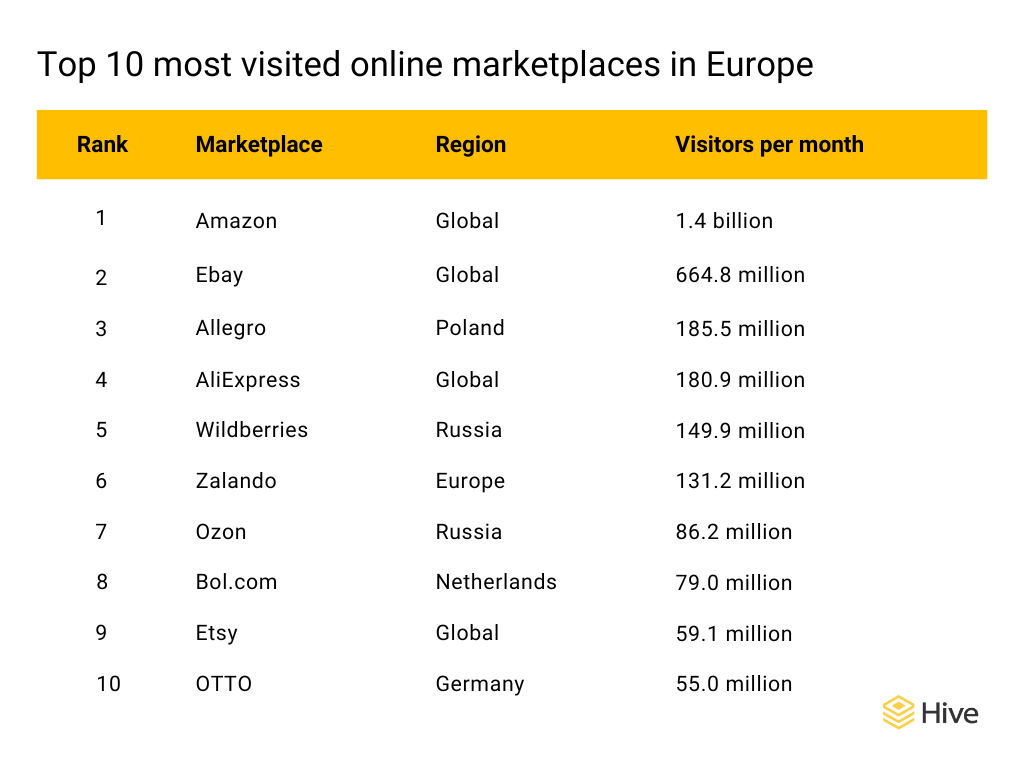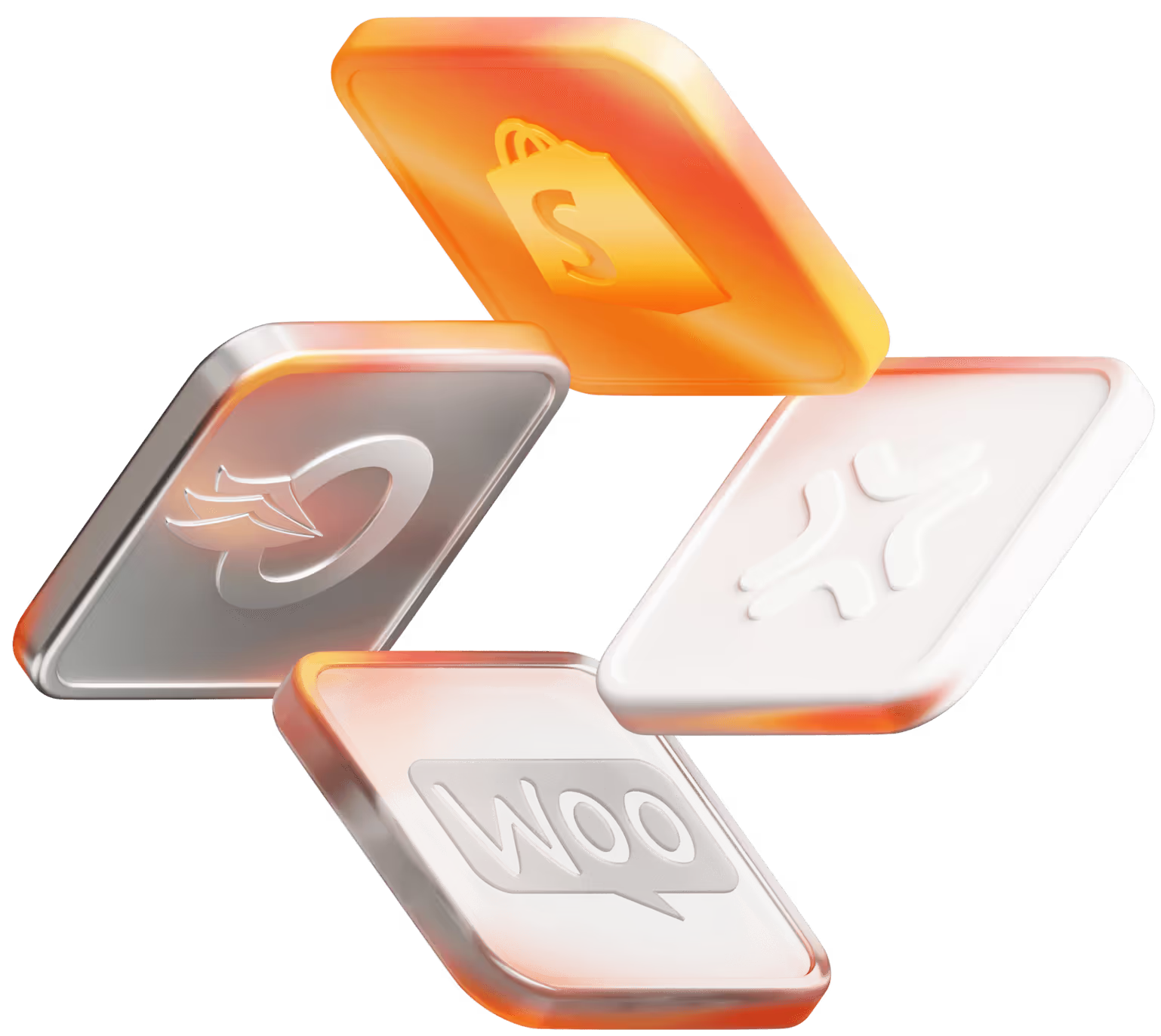The ultimate guide to e-commerce marketplaces in Europe
Find out which online marketplaces are the most popular across Europe, how much it costs to sell on them, and the pros and cons of selling using an online marketplace.

Online marketplaces are a powerful tool for growing your online business. The world’s largest online marketplaces attract over 1 billion shoppers per month. That’s one of the main reasons why more and more online retailers are choosing to sell their products on these popular shopping sites.
Choosing the right online marketplaces for your brand depends on multiple factors, including:
- Which types of products you sell
- Which regions and markets you want to target
- The pros and cons of working with each marketplace
- How to manage your logistics when selling through a marketplace
To maximise your profits when selling through marketplaces, it’s important to understand how each platform operates. What are the fees and requirements involved? How do local markets feel about each marketplace? Will selling on a specific marketplace enhance your brand? Do you have the logistics infrastructure in place to sell to a potentially much larger market?
In this guide, we break down the top online selling platforms across all major markets in Europe. This information will help you in your search for the marketplaces that fit best with your brand and your customers.
We will cover:
- What are online marketplaces?
- Why sell on an online marketplace?
- The top online marketplaces in:
- Germany
- France
- The UK
- Spain
- Italy
- Netherlands, Belgium, Luxembourg
- Poland
- Scandinavia
What are online marketplaces?
Online marketplaces are buying and selling sites that allow multiple retailers to sell their products side by side. As a retailer, you pay a fee for selling your products and you must follow the rules set by the marketplace.
Europe’s top online marketplaces are:

Yet the list does not stop there. There are over 150 online marketplaces around the world, catering to every corner of the market. In Europe, there are fashion marketplaces such as Zalando and Fullbeauty, live auction marketplaces such as Tophatter which targets bargain shoppers, and niche marketplaces like Bonanza and Fruugo.
Today, 44% of online product searches in Europe start on online marketplaces (the number is 52% among Gen Z shoppers). This means consumers are no longer even searching on Google for a product, they are just going directly to Amazon, eBay or the marketplace of their choice.
Why sell on an online marketplace?
The European e-commerce market expanded by 13% from 2020 to 2021, from €633 billion (£554 billion) to €718 billion (£600 billion). In 2022, analysts forecast further growth of 11%, topping out at €797 billion (£667 billion).
With this trend towards double-digit growth rates, the e-commerce industry is continually developing new strategies to reach more customers. Standing out from your competitors with an excellent customer experience and top service are crucial. This is why many retailers are turning to online marketplaces. They offer many major advantages, such as:
- Fast setup: The best marketplaces offer an easy online environment where retailers can easily put their products on the market, without a huge IT workload.
- Large customer bases: Even if a customer has never heard of your brand, they are very likely to search for products like yours on marketplaces like Amazon and eBay. In fact, marketplaces are 5 times more likely than your own website to be the starting place for a consumer’s product search.
- Excellent customer experiences: Leading marketplaces have set the new standard for excellent customer service. Amazon alone has probably done more than any other company to transform the way people shop online.
- Scalability: When selling on a global platform like Amazon or Etsy, you can expand your business to new markets around the world.
At the same time, there are also some drawbacks:
- Costs: Most marketplaces, including Amazon and eBay, charge commissions or other fees.
- Terms and conditions: Marketplaces may impose strict terms and conditions that you must obey.
- Less brand recognition: When selling on a marketplace, it is harder to express your company’s brand, because your products will appear in a standardised environment alongside other brands.
- Less control over your data: When selling via marketplaces, you do not own your customer data, which limits your ability to fine-tune your marketing strategy.
Country-by-country guide to online marketplaces in Europe - the biggest marketplaces in Europe
Now that you have gained an overview of what online marketplaces can offer, let’s dive into each major European e-commerce market and look at the top buying and selling sites in Europe. We’ll also talk about the pros and cons of using marketplaces in each country, along with any specific details you should keep in mind when considering which marketplace to use.
Germany

We start with Europe’s most populous country: Germany. With 96% of the German population actively using the internet, the German e-commerce market is projected to reach €73.6 billion (£61.58 billion) in 2022. In 2021, 66% of Germans between the ages of 16 and 74 said they shopped online.
Online marketplaces are very popular among German shoppers, now accounting for over 50% of all purchases made online in the country. In 2020, 88% of German consumers shopped on Amazon at least once, while 56% bought on eBay and 31% bought on Zalando. This means that selling on marketplaces is a major benefit to retailers wishing to penetrate the vast German market.
The top five e-commerce marketplaces in Germany
1. Amazon.de
Visits per month in Germany: 488 million
Category: general
Fee for retailers: €39 monthly, plus variable commission per sale (usually around 15% on the first €45 of the sale price and 7% commission on any amount above the €45 threshold). Additional fees apply if you use Amazon's e-fulfilment service, FBA.
2. eBay.de
Visits per month in Germany: 193 million
Category: general
Fee for retailers: Starting at €39.95 per month, plus Variable fees, depending on selected services; 4.5% to 12% commission per sale, depending on the product category.
3. Otto.de
Visits per month in Germany: 53 million
Category: general
Fee for retailers: €39 monthly, plus 12-15% commission per sale for most categories.
4. Zalando.de
Visits per month in Germany: 30 million
Category: Fashion and beauty
Fee for retailers: 5-25% commission per sale, depending on the product.
5. Etsy.de
Visits per month in Germany: 30 million
Category: Arts and crafts
Fee for retailers: 20 cents plus 3.5% commission for each sale.
Advantages of online marketplaces in Germany
- Considering their overwhelming popularity in Germany, online marketplaces are generally a wise platform for ecommerce retailers, despite the fees involved.
- Otto.de is a very popular local brand that caters traditionally to an older and mainly German-speaking audience. Selling on Otto.de may help you reach audiences that prefer to buy from a local brand rather than Amazon or eBay.
Disadvantages of online marketplaces in Germany
- Otto.de is less open to foreign retailers than other popular marketplaces in Germany. You may only sell on Otto.de if you ship from a German warehouse, charge standard German VAT (19%) and offer German-speaking customer service.
- While Amazon is enormously popular in Germany, 44% of Germans say they find its market position to be oversized, and 88% of those people say they buy less often from Amazon for that reason.
- Fiercely loyal to local brands, two-thirds of Germans support a digital tax for online retail giants like Amazon, which may make some online marketplaces less profitable here in the future.
- From May 2022, Amazon applies a 4.3% fuel and inflation surcharge if you use Fulfilment by Amazon (FBA) to deliver your goods sold through the Amazon Marketplace in Germany.
France

The seventh-largest e-commerce market in the world, France generated €112 billion (£93.7 billion) in e-commerce revenue in 2020. Around 93% of the population here are active internet users, and 81.4% of those people say they also shop online.
Like in most European countries, online marketplaces dominate the e-commerce market in France. In 2021, over 53% of French consumers say they had shopped on Amazon that year. While major international marketplaces top the rankings in most countries, France’s top-five list includes a couple of local retail platforms.
The top five e-commerce marketplaces in France
1. Amazon.fr
Visits per month in France: 166 million
Category: general
Fee for retailers: €39 monthly, plus variable commission per order based on product categories (generally around 15.45% for the portion of the total sales price up to €45.00 and 7.21% for any portion of the total sales price greater than €45.00); Additional fees apply if you use Amazon's e-fulfilment service, FBA.
2. Cdiscount.fr
Visits per month in France: 51 million
Category: general, though especially good for electronics
Fee for retailers: €39.99 monthly, plus 2-15% commission per sale, depending on product category.
3. eBay.fr
Visits per month in France: 39 million
Category: general
Fee for retailers: starting at €19.50 per month, plus Variable fees, depending on selected services; 4.5% to 12% commission per sale, depending on the product category.
4. AliExpress.fr
Visits per month in France: 33 million
Category: general
Fee for retailers: 5-8% commission per sale
5. LeroyMerlin.fr
Visits per month in France: 33 million
Category: Home and garden
Fee for retailers: €39 monthly, plus variable commission per sale.
Advantages of online marketplaces in France
- Though Amazon is the clear market leader here, the French e-commerce market is home to a range of competitive local selling platforms which, amongst themselves, are almost equally popular with consumers. This gives online retailers a good range of locally approved platforms to choose from.
- AliExpress charges no fixed or monthly fees, meaning you only pay when you actually make a sale. This makes it a low-risk platform for retailers who wish to sell in France.
- Cdiscount is a must for any retailer specialising in electronics.
Disadvantages of online marketplaces in France
- While extremely popular, Cdiscount is also highly competitive. You will be competing against popular French brands, which may be difficult if you are new to the market. Plus, the Cdiscount site operates only in French, although English-speaking account managers are available to retailers.
- Many French marketplaces require that you offer product information and customer support in French.
- From May 2022, Amazon applies a 4.3% fuel and inflation surcharge if you use Fulfilment by Amazon (FBA) to deliver your goods sold through the Amazon Marketplace in France.
The UK

The UK is Europe’s largest e-commerce market by far, with 95% internet penetration and an astonishing 93% of consumers who say they shop online. The UK e-commerce market was valued at £182.9 billion in 2021 and is likely to account for over 36% of total retail sales in 2022. Always at the forefront of online shopping, the UK is also home to Europe’s largest mobile retail industry, with mobile shopping (m-commerce) totalling 72.9% of total e-commerce sales in 2021.
Major online marketplaces dominate the e-commerce landscape here as well. Amazon alone accounts for 30% of the UK’s total online shopping (the equivalent of 5.5% of total retail sales in the country). While the international giants top the ranks, one local hero is trailing in fifth place.
The top five e-commerce marketplaces in the UK
1. Amazon.co.uk
Visits per month in the UK: 474 million
Category: general
Fee for retailers: £25 per month, plus commission of up to 15.3%, depending on the product category; Additional fees apply if you use Amazon's e-fulfilment service, FBA.
2. eBay.co.uk
Visits per month in the UK: 279 million
Category: general
Fee for retailers: starting at £25 per month, plus Variable fees, depending on selected services; variable commissions per sale, depending on the product category
3. Etsy.co.uk
Visits per month in the UK: 48 million
Category: Arts and crafts
Fee for retailers: 6.5% commission per sale
4. Wayfair.co.uk
Visits per month in the UK: 20 million
Category: Home and furniture
Fee for retailers: no fees
5. Onbuy.com
Visits per month in the UK: 10 million
Category: General
Fee for retailers: 5-9% commission per sale
Advantages of online marketplaces in the UK
- UK marketplaces give you access to Europe’s most vibrant ecommerce market.
- Wayfair does not charge fees, but instead pays you the wholesale price for your merchandise, which they then sell at a price they set themselves.
- OnBuy.com is a popular UK brand which entered the market as a local alternative to Amazon. Selling on OnBuy gives you local credibility, plus it is very affordable, with no monthly fees.
Disadvantages of online marketplaces in the UK
- Wayfair is not a general selling platform, so you can only take advantage of its zero-fee model if you sell products that fit within its product range (home furnishings and furniture).
- From May 2022, Amazon applies a 4.3% fuel and inflation surcharge if you use Fulfilment by Amazon (FBA) to deliver your goods sold through the Amazon Marketplace in the UK.
- As with any products imported from outside the UK, merchandise sold by European retailers via UK marketplaces are also subject to customs clearance ever since Brexit went into effect.
Spain

The e-commerce market in Spain is smaller compared to other Western European countries. But it is rapidly growing. In 2021, internet penetration in the country was 83%, with 63% of consumers saying they have shopped online. Smartphones are the most popular device for online shopping here, accounting for 61% of all transactions.
Online marketplaces have become a major force in Spanish e-commerce, with 89% of online shoppers saying they have shopped on Amazon.es this year. Major international selling platforms top the rankings here, with only one local company, El Corte Inglés, reaching the top five.
The top five e-commerce marketplaces in Spain
1. Amazon.es
Visits per month in Spain: 137.4 million
Category: general
Fee for retailers: €39 monthly, plus variable commission per order based on product categories (generally around 15.45% for the portion of the total sales price up to €45.00 and 7.21% for any portion of the total sales price greater than €45.00); Additional fees apply if you use Amazon's e-fulfilment service, FBA.
2. AliExpress.com
Visits per month in Spain: 40 million
Category: general
Fee for retailers: no monthly fee. 5-8% commission per sale
3. ElCorteInglés.es
Visits per month in Spain: 26.3 million
Category: General, especially good for luxury goods
Fee for retailers: no monthly fee. Variable commission depending on product category
4. eBay.es
Visits per month in Spain: 14.9 million
Category: general
Fee for retailers: starting at €19.50 per month, plus Variable fees, depending on selected services; 4.5% to 12% commission per sale, depending on the product category
5. Decathlon.es
Visits per month in Spain: 8.9 million
Category: general
Fee for retailers: €40 monthly fee, plus variable commission based on product category
Advantages of online marketplaces in Spain
- While Spain's e-commerce market is not yet as large as in other countries, it is rapidly growing. It is a good time to enter the market, and e-commerce retailers still have many opportunities to stand out from competitors here.
- Zero-fee, commission-only platforms like AliExpress and El Corte Inglés are a low-risk alternative to bigger platforms like Amazon,es, which charges higher commissions.
- Still, considering the overwhelming popularity of Amazon.es, the fixed monthly fee and variable commissions may be worth the price.
Disadvantages of online marketplaces in Spain
- As in many countries, offering product descriptions and customer support in the local language is a must. You will struggle to stand out in Spanish marketplaces without an authentic, localised approach.
- Spanish consumers are more cost-sensitive compared to many other Western European countries, as they are generally used to a lower cost of living. For example, the cost of living in Spain is 22% lower than it is in Germany. This means you may have to lower your prices if you want to compete with local brands.
- From May 2022, Amazon applies a 4.3% fuel and inflation surcharge if you use Fulfilment by Amazon (FBA) to deliver your goods sold through the Amazon Marketplace in Spain.
Italy

Italy's e-commerce market is growing even faster than Spain's, with an incredible 33% CAGR in 2021, topping out at €64 billion (£53.7 billion). Online selling now accounts for 17% of the country's retail volume. Over 76% of the country's total population uses the internet, with 90% of adults owning a smartphone.
As local brands are mostly still in the process of opening up digital sales channels, the e-commerce market in Italy has become dominated by major international companies that have the experience and infrastructure to succeed here. As a result, 67% of Italians have shopped on foreign websites and nearly all of them have shopped on popular marketplaces: 95% on Amazon and around 50% on eBay and Zalando.
(76.9), Mediaworld (11.3), UniEuro (10.4), AliExpress (8.65),
The top five e-commerce marketplaces in Italy
1. Amazon.it
Visits per month in Italy: 180.5 million
Category: general
Fee for retailers: €39 monthly, plus variable commission per order based on product categories (generally around 15.45% for the portion of the total sales price up to €45.00 and 7.21% for any portion of the total sales price greater than €45.00); Additional fees apply if you use Amazon's e-fulfilment service, FBA.
2. eBay.it
Visits per month in Italy: 76.9 million
Category: general
Fee for retailers: starting at €19.50 per month, plus Variable fees, depending on selected services; 4.5% to 12% commission per sale, depending on the product category
3. Mediaworld.it
Visits per month in Italy: 11.3 million
Category: electronics
Fee for retailers: exact fees unknown
4. UniEuro.it
Visits per month: 10.4 million
Category: electronics
Fee for retailers: exact fees unknown
5. AliExpress.com
Visits per month in Italy: 8.65 million
Category: general
Fee for retailers: no monthly fee. 5-8% commission per sale
Advantages of online marketplaces in Italy
- Foreign retailers are generally well accepted here, and the major international marketplaces massively outperform smaller local platforms.
- The market is growing fast, with many opportunities to reach new customers and stand out from your competitors.
Disadvantages of online marketplaces in Italy
- Doing business in the local language is essential. Mediaworld.it and UniEuro.it only offer support and communications in English, for example.
- Like in Spain, consumers in Italy are cost-sensitive compared with other European countries. The cost of living in Italy is 32% lower than in the UK, for example. This makes it necessary to compete strongly on price when selling here.
- From May 2022, Amazon applies a 4.3% fuel and inflation surcharge if you use Fulfilment by Amazon (FBA) to deliver your goods sold through the Amazon Marketplace in Italy.
Netherlands, Belgium, Luxembourg (Benelux)

The Benelux region (Netherlands, Belgium and Luxembourg) is home to a vibrant online economy. Particularly the Netherlands is a vital e-commerce market in Western Europe, with 96% of its consumers saying that they shop online. That number is about 90% for Belgium and over 83% for Luxembourg. The Netherlands is a particularly attractive e-commerce market, because online shopping is popular among people of all ages, including 80% of elderly people. And with smartphone ownership around 90% throughout the region, mobile shopping is increasingly important.
Unlike their large neighbours Germany, France and the UK, the Benelux countries lacked a local Amazon presence until the launch of Amazon.nl in 2018. Cross-border shopping on Amazon.de and Amazon.fr remain popular in the region. In July 2022, Amazon announced it will launch Amazon.be for the Belgian market soon.
The top five e-commerce marketplaces in the Netherlands, Belgium, and Luxembourg
1. Bol.com
Visits per month: 66.9 million
Category: general
Fee for retailers: No monthly fee; between 4 and 15% commission per sale, depending on product category
2. Amazon.nl
Visits per month: 23 million
Category: general
Fee for retailers: €39 monthly, plus variable commission per order based on product categories (generally around 15.45% for the portion of the total sales price up to €45.00 and 7.21% for any portion of the total sales price greater than €45.00); Additional fees apply if you use Amazon's e-fulfilment service, FBA.
3. Amazon.fr
Visits per month: unknown
Category: general
Fee for retailers: €39 monthly, plus variable commission per order based on product categories (generally around 15.45% for the portion of the total sales price up to €45.00 and 7.21% for any portion of the total sales price greater than €45.00); Additional fees apply if you use Amazon's e-fulfilment service, FBA.
4. Zalando.nl
Visits per month: 13.7 million
Category: Fashion and beauty
Fee for retailers: No monthly fee; commission between 5 and 25% depending on product category
5. AliExpress.com
Visits per month: unknown
Category: general
Fees for retailers: no monthly fee; commission between 5 and 8% per sale
Advantages of online marketplaces in BeNeLux
- Benelux shoppers are internet savvy and open to buying from foreign marketplaces online.
- Most Dutch marketplaces also offer English-language support, making them easily accessible to foreign sellers.
- Luxembourg's population has the highest level of disposable income in Europe. The Netherlands and Belgium also rank in the top five. This means shoppers are less cost-sensitive and focus more heavily on quality and excellent customer service.
Disadvantages of online marketplaces in BeNeLux
- The Belgian and Luxembourg markets are diverse in terms of language, shopping either in Dutch, French, German, English or, less often, Luxembourgish, depending on their location. It is important to understand which languages to use to target your market in this region. It can be a sensitive topic which requires expert input.
- Not so much a disadvantage as a requirement: Any retailer wishing to sell in the Netherlands must offer the extremely popular iDEAL bank transfer service as a payment method option, which is used in around 80% of online transactions there.
Poland

The sixth-largest country in Europe by population, Poland is home to a thriving e-commerce market. Around 77% of the population are active internet users, and 80% of those users say they shop online.
Online marketplaces dominate the e-commerce landscape here too. Yet Polish shoppers are far more loyal to local companies than any other major European market. Local e-retail giant Allegro.pl takes the lead, while Amazon.com trailing behind here.
The top five e-commerce marketplaces in Poland
1. Allegro.pl
Visits per month in Poland: 187.5 million
Category: general
Fee for retailers: No monthly fee; commission between 4 and 11% per sale.
2. Olx.pl
Visits per month in Poland: 96 million
Category: general
Fee for retailers: No monthly fee; fees are charged for ads, shipping and payment services
3. AliExpress.com
Visits per month in Poland: Exact number unknown
Category: general
Fee for retailers: No monthly fee; commission between 5 and 8% per sale
4. Sprzedajemy.pl
Visits per month in Poland: 8.6 million
Category: general
Fee for retailers: fee structure unknown
5. Amazon.com
Visits per month in Poland: exact number unknown
Category: general
Fee for retailers: €39 monthly, plus variable commission per order based on product categories (generally around 15.45% for the portion of the total sales price up to €45.00 and 7.21% for any portion of the total sales price greater than €45.00); Additional fees apply if you use Amazon's e-fulfilment service, FBA.
Advantages of online marketplaces in Poland
- Allegro.pl charges some of the lowest commissions of all European online marketplaces. It is also very welcoming to foreign sellers, offering excellent support in English.
- The marketplaces offer instant access to the large, fast-growing Polish e-commerce market.
Disadvantages of online marketplaces in Poland
- Shoppers in Poland are generally more cost-sensitive, compared to Western European shoppers. Disposable income among Polish households is about three-fifths the level among German households.
- Communication in Polish is absolutely essential for reaching Polish consumers, despite the excellent English-language support offered by the major marketplaces here.
The Nordics: Sweden, Denmark, Norway and Finland

The Nordic countries (Sweden, Denmark, Norway and Finland) are home to highly digital populations, 62% of whom shop online every month (more than 12 million customers per month). Sweden dominates the e-commerce market, also having a much higher population than its neighbours. In Sweden alone, 68% of consumers shop online.
Traditionally very open to foreign business, over one-third (36%) of online consumers in the Nordic region buy from international retailers each month. Since launching in 2020, Amazon.se has gained market share in the online market here, but local marketplaces remain highly popular.
The top five e-commerce marketplaces in Scandinavia
1. Elgiganten.se
Visits per month in Scandinavia: 17.43 million
Category: electronics
Fee for retailers: exact fees unknown
2. Amazon.se
Visits per month in Scandinavia: 14.9 million
Category: general
Fee for retailers: 410 SKR per month, plus variable commission per order based on product categories; Additional fees apply if you use Amazon's e-fulfilment service, FBA.
3. Cdon.se
Visits per month in Scandinavia: 10.83 million
Category: general
Fee for retailers: exact fees unknown
4. Wish.com
Visits per month in Scandinavia: exact number unknown
Category: general
Fee for retailers: Invitation only; variable commission
5. Zalando.com
Visits per month in Scandinavia: Exact number unknown
Category: Fashion & beauty
Fee for retailers: Commission between 5 and 25% per sale, depending on category
Advantages of online marketplaces in Scandinavia
- The Nordic population generally enjoys a high level of disposable income, with a focus on quality and service above price.
- Online marketplaces such as Amazon.se and Zalando.com offer retail support in English as well as local languages.
- Nordic shoppers are open to buying from international retailers and even communicating in English, though native-language support is beneficial.
Disadvantages of online marketplaces in Scandinavia
- Elgiganten and Cdon offer retailer support in Scandinavian languages only.
Grow your business with the right partners
As with any business decision, each marketplace offers advantages and disadvantages. It is important to weigh your options carefully and seek local expertise when entering a new market.
Another important consideration is how selling via an online marketplace will affect your logistics. While major platforms like Amazon and Wayfair offer their own e-fulfilment options for retailers, these also involve additional fees and strict rules.
If your brand is expanding to a point where you need to upgrade your logistics management, you can benefit from working with a third-party logistics (3PL) partner like Hive. Our no-code integration seamlessly connects with all major online marketplaces, such as Amazon.
We offer you a hassle-free, all-in-one logistics solution for all your shipping and warehousing needs. That way, you can focus on your core business or winning new customers and selling great products.








.jpeg)
.png)



.png)



.png)




.png)

.png)
.png)

.png)
